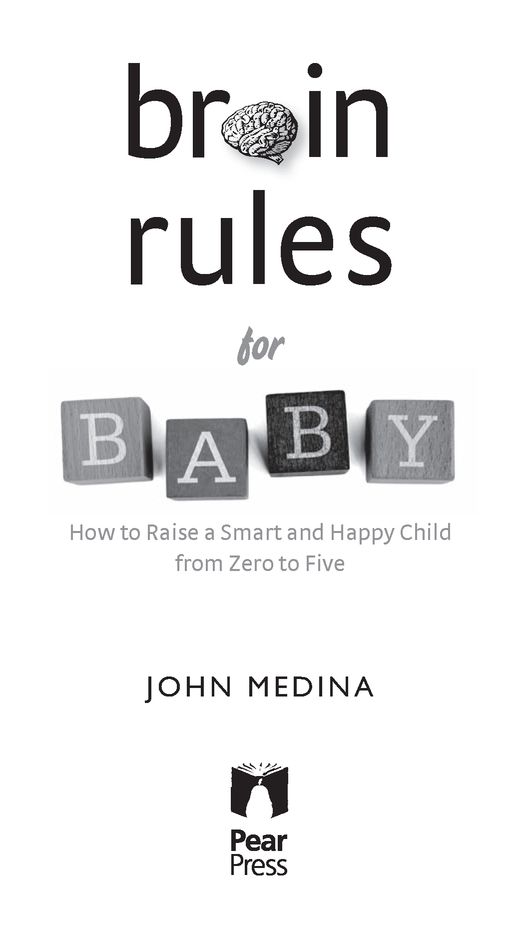Brain Rules for Baby
Read Brain Rules for Baby Online
Authors: John Medina


Table of Contents

To my amazing kids and their even more amazing mother, for teaching me that when confronted with a choice between two equally plausible theories, it is always best to take the one that is funnier.
brain rules

pregnancy
Babies develop an active mental life in the womb
Stressed mom, stressed baby
Eat right, stay fit, get lots of pedicures
Stressed mom, stressed baby
Eat right, stay fit, get lots of pedicures

relationship
Happy marriage, happy baby
The brain seeks safety above all
What is obvious to you is obvious to you
The brain seeks safety above all
What is obvious to you is obvious to you

smart baby
The brain cares about survival before learning
Intelligence is more than IQ
Face time, not screen time
Intelligence is more than IQ
Face time, not screen time
Safe baby, smart baby
Praise effort, not IQ
Guided play—every day
Emotions, not emoticons
Praise effort, not IQ
Guided play—every day
Emotions, not emoticons

happy baby
Babies are born with their own temperament
Emotions are just Post-it notes
Empathy makes good friends
Emotions are just Post-it notes
Empathy makes good friends
The brain craves community
Empathy soothes the nerves
Labeling emotions calms big feelings
Empathy soothes the nerves
Labeling emotions calms big feelings

moral baby
Babies are born with moral sensibilities
Discipline + warm heart = moral kid
Let your yes be yes and your no be no
Discipline + warm heart = moral kid
Let your yes be yes and your no be no
introduction
Every time I lectured to a group of parents-to-be about baby brain development, I made a mistake. The parents, I thought, had come for a tasty helping of science about the brain in utero—a little neural crest biology here, a little axonal migration there. But in the Q&A session after each lecture, the questions were always the same. The first, delivered by a very pregnant woman one rainy night in Seattle, was,“What can my baby learn while she is still in my womb? Another woman asked, “What’s going to happen to my marriage after we bring our baby home?” A dad delivered the third question, with some authority: “How do I get my kid into Harvard?” An anxious mom asked the fourth question: “How can I make sure my little girl is going to be happy?” And the fifth belonged to a downright noble grandmother. “How do I make my grandchild
good?
” she asked. She had taken over parenting responsibilities from a drug-addicted daughter. She did not want the same thing to happen again.
good?
” she asked. She had taken over parenting responsibilities from a drug-addicted daughter. She did not want the same thing to happen again.
No matter how many times I tried to steer the conversation toward the esoteric world of neural differentiation, parents asked
variations on these same five questions—over and over again. Finally, I realized my mistake. I was giving parents Ivory Tower when they needed Ivory Soap. So, this book will not be concerned with the nature of gene regulation in the developing rhombencephalon.
Brain Rules for Baby
instead will be guided by the practical questions my audiences keep asking.
variations on these same five questions—over and over again. Finally, I realized my mistake. I was giving parents Ivory Tower when they needed Ivory Soap. So, this book will not be concerned with the nature of gene regulation in the developing rhombencephalon.
Brain Rules for Baby
instead will be guided by the practical questions my audiences keep asking.
“Brain Rules” are what I call the things we know for sure about how the early-childhood brain works. Each one is quarried from the larger seams of behavioral psychology, cellular biology, and molecular biology. Each was selected for its ability to assist newly minted moms and dads in the daunting task of caring for a helpless little human.
I certainly understand the need for answers. Having a first child is like swallowing an intoxicating drink made of equal parts joy and terror, chased with a bucketful of transitions nobody ever tells you about. I know firsthand: I have two boys, both of whom came with bewildering questions, behavioral issues, and no instructions. I soon learned that’s not all they came with. They possessed a gravitational pull that could wrest from me a ferocious love and a tenacious loyalty. They also were magnetic: I could not help staring at their perfect fingernails, clear eyes, dramatic shocks of hair. By the time my second child was born, I understood that it is possible to split up love ad infinitum and not decrease any single portion of it. With parenting, it is truly possible to multiply by dividing.
Other books
Hacking the SEAL (Saving the SEALs Series Book 2) by Leslie North
Ancient Blood: The Fallen by Renea Taylor
Danger in the Dust by Sally Grindley
Girls' Guide to Flirting with Danger by Kimberly Lang
Adam's List by Ann, Jennifer
Proposal in Room 309 by Joss Wood
Little Brats Jenna: Forbidden Taboo Erotica by Selena Kitt
The Double Tongue by William Golding
Rogue of the Isles by Cynthia Breeding
Angel Wings by Stengl, Suzanne